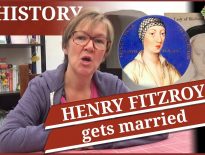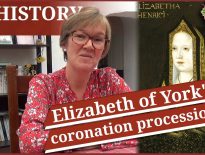On this day in Tudor history, 25th November 1487, the Feast of St Catherine, Elizabeth of York, queen consort of Henry VII and mother of one-year-old Arthur Tudor, was crowned queen at Westminster Abbey.
In today's talk, I share details of Elizabeth of York's coronation, including Elizabeth's apparel, and who attended, plus a list of some of the interesting dishes served at Elizabeth of York's coronation banquet which included swan and seal!
Also on this day in history:
- 1467 – Birth of Thomas Dacre, 2nd Baron of Gilsland, magnate and soldier, in Cumberland. He was the son of Humphrey Dacre, 1st Baron Dacre, and Mabel (née Parr), great-aunt of Queen Catherine Parr. Dacre eloped with Elizabeth Greystoke, 6th Baroness Greystoke, around 1488, and the couple had seven children. Dacre served under Thomas Howard, Earl of Surrey, at the 1513 Battle of Flodden.
- 1545 – Death of Sir Thomas Legh, lawyer, member of Parliament, diplomat and ecclesiastical administrator. He was buried at St Leonard's Church, Shoreditch. Legh served Henry VIII as ambassador to Denmark. He interrogated Bishop John Fisher before his trial in 1535, was a Commissioner in the Visitations of the Monasteries in 1535-36, and examined prisoners involved in the 1536 Pilgrimage of Grace rebellion.
- 1605 – Death of George Withers, Church of England clergyman and Archdeacon of Colchester, at Danbury in Essex, where he was rector. Withers was the author of the 1579 “Certaine godly instructions, verie necessarie to be learned of the younger sorte before they be admitted to be partakers of the holie communion” and the 1585 “An ABC for Laymen, otherwise called the Laymans Letters”. He also compiled “A view of the marginal notes of the popish testament, translated into English by the English fugitive papists at Rhemes in France”, which he dedicated to Archbishop John Whitgift.
- 1626 – Death of Edward Alleyn, Elizabethan actor, patron, theatre builder and founder of Dulwich College and Alleyn's School. He was buried in the chapel of Dulwich College.
Transcript:
On this day in Tudor history, 25th November 1487, the Feast of St Catherine, Elizabeth of York, queen consort of Henry VII and mother of one-year-old Arthur Tudor, was crowned queen at Westminster Abbey.
As I explained yesterday, Elizabeth’s coronation celebrations had kicked off with a river procession from Greenwich to the Tower of London on the 23rd November, followed by the creation of eleven knights of the bath, and then, on 24th November, a coronation procession through the streets of London from the Tower to Westminster.
19th century historian Nicholas Harris Nicolas, in his Memoir of Elizabeth of York, which is drawn from primary sources, writes of how, on the morning of 25th November 1487, Elizabeth proceeded from her lodgings to Westminster Hall dressed in “a kirtle and mantle of purple velvet, furred with ermine laced in front” and wearing a gold circlet set with pearls and jewels on her head. She processed into the abbey under a canopy of state, walking on new ray cloth, which was ripped to pieces by the crowd to take home as souvenirs after she had walked on it. The Earl of Arundel bore the staff with the dove, the Duke of Suffolk bore the sceptre, and the Duke of Bedford bore the crown. Elizabeth was flanked by the Bishops of Winchester and Ely, and behind her walked her sister, Cecily, holding her train. Nicolas writes of how she entered Westminster Abbey by the west door and made her way to a seat near the pulpit. Her husband, King Henry VII, watched proceedings from a latticed stage situated between the pulpit and high altar.
Nicolas states that her coronation “was attended by fifteen bishops, seventeen abbots, two dukes, twelve earls, two viscounts, twenty barons, the heirs apparent of the Earls of Suffolk and Devonshire; the King’s mother, and the Lady Cecily, the Queen’s sister, three duchesses, four countesses, seven baronesses, thirty-one knight bannerets, one hundred and fifty knights, besides their wives and other gentlewomen; but neither the Queen’s mother, nor any of her sisters, excepting Cecily, appear to have been present.”
Historian Amy Licence, in her biography of Elizabeth of York, which I would highly recommend, explains that at her coronation, Elizabeth “was anointed twice before the huge assembly of nobles, once on the chest and once on the head before receiving a ring for the fourth finger of her right hand, a gold crown, sceptre and rod of gold.” Elizabeth then processed from the abbey to Westminster Hall where there was a sumptuous coronation banquet in her honour. Henry VII and his mother, Lady Margaret Beaufort, viewed the banquet from a latticed stage which Nicolas says was “erected out of a window on the left side of the hall.”
In the book “Elizabeth of York”, A. Okerlund lists the food served at the coronation banquet which were recorded by a herald. The first course included boar, venison, broth, pheasant, swan, crane, pike, heron, carp, kid (baby goat), rabbit and fruit desserts, amongst other dishes, and then a “soteltie, with writing of balads”, a subtlety usually being an amazing display of marchpane, pastry or spun sugar which would have been moulded into a building or animal. The second course included hippocras, broth, peacock, bittern, patridge, sturgeon, seal, quails, larks, crayfish, quince, marchpane, fritters, jellied desserts, castles made from jelly, and another subtlety.
After the Garter King of Arms had proclaimed Elizabeth’s titles and thanks had been given to her, it was time to wrap up the banquet with fruit and wafers, and then hippocras and wafers. Then, according to the records “the queen departed with God’s blessing, and to the rejoicing of many a true Englishman’s heart”.
It was the end of a long day for the queen.
Elizabeth of York was Henry VII's queen consort from their marriage in January 1486 until her death on 11th February 1503. Henry VII never remarried and he died in April 1509.




Leave a Reply